Precise Temperature Measurement Through Wavelength Modulation Heterodyne Phase-Sensitive Dispersion Spectroscopy
Abstract
1. Introduction
2. Theory
3. Sensor Configuration and Parameter Optimization
3.1. Sensor Configuration
3.2. Parameter Optimization
3.3. Temperature Devices
4. Results and Discussion
4.1. Static Temperature Measurement Results
4.2. Dynamic Temperature Measurement Results
5. Conclusions
Author Contributions
Funding
Institutional Review Board Statement
Informed Consent Statement
Data Availability Statement
Conflicts of Interest
References
- Goldenstein, C.S.; Spearrin, R.M.; Jeffries, J.B.; Hanson, R.K. Infrared Laser-Absorption Sensing for Combustion Gases. Prog. Energy Combust. Sci. 2017, 60, 132–176. [Google Scholar] [CrossRef]
- Li, J.; Zhang, C.; Wei, Y.; Du, Z.; Sun, F.; Ji, Y.; Yang, X.; Liu, C. In Situ, Portable and Robust Laser Sensor for Simultaneous Measurement of Ammonia, Water Vapor and Temperature in Denitrification Processes of Coal Fired Power Plants. Sens. Actuators B Chem. 2020, 305, 127533. [Google Scholar] [CrossRef]
- Duan, K.; Ma, L.; Yi, Y.; Ren, W. Tunable Diode Laser-Based Two-Line Thermometry: A Noncontact Thermometer for Active Body Temperature Measurement. Appl. Opt. 2021, 60, 7036–7042. [Google Scholar] [CrossRef] [PubMed]
- Sane, A.; Satija, A.; Lucht, R.P.; Gore, J.P. Simultaneous CO Concentration and Temperature Measurements Using Tunable Diode Laser Absorption Spectroscopy near 2.3 Μm. Appl. Phys. B 2014, 117, 7–18. [Google Scholar] [CrossRef]
- Benoy, T.; Wilson, D.; Lengden, M.; Armstrong, I.; Stewart, G.; Johnstone, W. Measurement of CO2 Concentration and Temperature in an Aero Engine Exhaust Plume Using Wavelength Modulation Spectroscopy. IEEE Sens. J. 2017, 17, 6409–6417. [Google Scholar] [CrossRef]
- Qu, Z.; Ghorbani, R.; Valiev, D.; Schmidt, F.M. Calibration-Free Scanned Wavelength Modulation Spectroscopy—Application to H2O and Temperature Sensing in Flames. Opt. Express 2015, 23, 16492. [Google Scholar] [CrossRef]
- Schultz, I.A.; Goldenstein, C.S.; Jeffries, J.B.; Hanson, R.K.; Rockwell, R.D.; Goyne, C.P. Diode Laser Absorption Sensor for Combustion Progress in a Model Scramjet. J. Propuls. Power 2014, 30, 550–557. [Google Scholar] [CrossRef]
- Murzyn, C.; Sims, A.; Krier, H.; Glumac, N. High Speed Temperature, Pressure, and Water Vapor Concentration Measurement in Explosive Fireballs Using Tunable Diode Laser Absorption Spectroscopy. Opt. Lasers Eng. 2018, 110, 186–192. [Google Scholar] [CrossRef]
- Martín-Mateos, P.; Acedo, P. Heterodyne Phase-Sensitive Detection for Calibration-Free Molecular Dispersion Spectroscopy. Opt. Express 2014, 22, 15143. [Google Scholar] [CrossRef]
- Wysocki, G.; Weidmann, D. Molecular Dispersion Spectroscopy for Chemical Sensing Using Chirped Mid-Infrared Quantum Cascade Laser. Opt. Express 2010, 18, 26123. [Google Scholar] [CrossRef]
- Nikodem, M.; Wysocki, G. Measuring Optically Thick Molecular Samples Using Chirped Laser Dispersion Spectroscopy. Opt. Lett. 2013, 38, 3834. [Google Scholar] [CrossRef] [PubMed]
- Nikodem, M.; Plant, G.; Sonnenfroh, D.; Wysocki, G. Open-Path Sensor for Atmospheric Methane Based on Chirped Laser Dispersion Spectroscopy. Appl. Phys. B 2015, 119, 3–9. [Google Scholar] [CrossRef]
- Nikodem, M.; Weidmann, D.; Smith, C.; Wysocki, G. Signal-to-Noise Ratio in Chirped Laser Dispersion Spectroscopy. Opt. Express 2012, 20, 644. [Google Scholar] [CrossRef]
- Ding, W.; Sun, L.; Yi, L.; Ming, X. Dual-Sideband Heterodyne of Dispersion Spectroscopy Based on Phase-Sensitive Detection. Appl. Opt. 2016, 55, 8698. [Google Scholar] [CrossRef]
- Martín-Mateos, P.; Hayden, J.; Acedo, P.; Lendl, B. Heterodyne Phase-Sensitive Dispersion Spectroscopy in the Mid-Infrared with a Quantum Cascade Laser. Anal. Chem. 2017, 89, 5916–5922. [Google Scholar] [CrossRef]
- Ma, L.; Wang, Z.; Cheong, K.-P.; Ning, H.; Ren, W. Temperature and H2O Sensing in Laminar Premixed Flames Using Mid-Infrared Heterodyne Phase-Sensitive Dispersion Spectroscopy. Appl. Phys. B 2018, 124, 117. [Google Scholar] [CrossRef]
- Duan, K.; Hu, M.; Ji, Y.; Lu, Z.; Yao, S.; Ren, W. High-Temperature Ammonia Detection Using Heterodyne Phase-Sensitive Dispersion Spectroscopy at 9.06 Μm. Fuel 2022, 325, 124852. [Google Scholar] [CrossRef]
- Wang, R.; Xu, L.; Huang, A.; Cao, Z. Simultaneous Telemetry of Temperature and Vibration by Laser Dispersion Spectroscopy. Opt. Lett. 2022, 47, 3956. [Google Scholar] [CrossRef]
- Wang, R.; Pang, Y.; Tang, X. Simultaneous Measurement of Temperature and Water Concentration Using a Novel Laser Dispersion Spectrum Extraction Method Immune to Carrier Phase Variation. Opt. Lasers Eng. 2023, 164, 107497. [Google Scholar] [CrossRef]
- Ma, L.; Wang, Z.; Cheong, K.-P.; Ning, H.; Ren, W. Mid-Infrared Heterodyne Phase-Sensitive Dispersion Spectroscopy in Flame Measurements. Proc. Combust. Inst. 2019, 37, 1329–1336. [Google Scholar] [CrossRef]
- Wang, R.; Xu, L. High-Precision Temperature Measurement Using Frequency-Division Multiplexing Laser Dispersion Spectroscopy for Dynamic Combustion Monitoring. IEEE Trans. Instrum. Meas. 2024, 73, 7003108. [Google Scholar] [CrossRef]
- Hu, M.; Ren, W. Wavelength-Modulation Dispersion Spectroscopy of NO with Heterodyne Phase-Sensitive Detection. Opt. Lett. 2022, 47, 2899. [Google Scholar] [CrossRef]
- Xu, L.; Hou, G.; Qiu, S.; Huang, A.; Zhang, H.; Cao, Z. Noise Immune TDLAS Temperature Measurement Through Spectrum Shifting by Using a Mach–Zehnder Interferometer. IEEE Trans. Instrum. Meas. 2021, 70, 7004009. [Google Scholar] [CrossRef]
- Wang, Z.; Cheong, K.-P.; Li, M.; Wang, Q.; Ren, W. Theoretical and Experimental Study of Heterodyne Phase-Sensitive Dispersion Spectroscopy with an Injection-Current-Modulated Quantum Cascade Laser. Sensors 2020, 20, 6176. [Google Scholar] [CrossRef]
- Nikodem, M.; Weidmann, D.; Wysocki, G. Chirped Laser Dispersion Spectroscopy with Harmonic Detection of Molecular Spectra. Appl. Phys. B 2012, 109, 477–483. [Google Scholar] [CrossRef]
- Hu, M.; Ventura, A.; Hayashi, J.G.; Poletti, F.; Yao, S.; Ren, W. Trace Gas Detection in a Hollow-Core Antiresonant Fiber with Heterodyne Phase-Sensitive Dispersion Spectroscopy. Sens. Actuators B Chem. 2022, 363, 131774. [Google Scholar] [CrossRef]
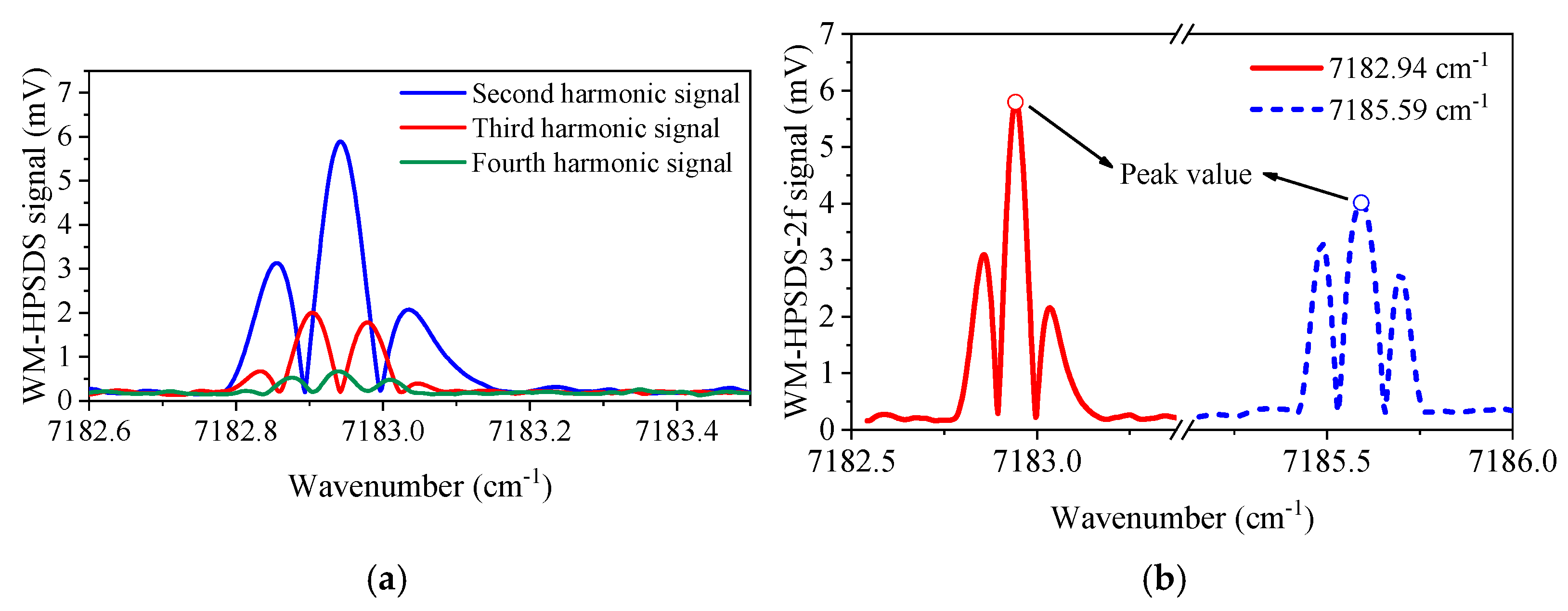
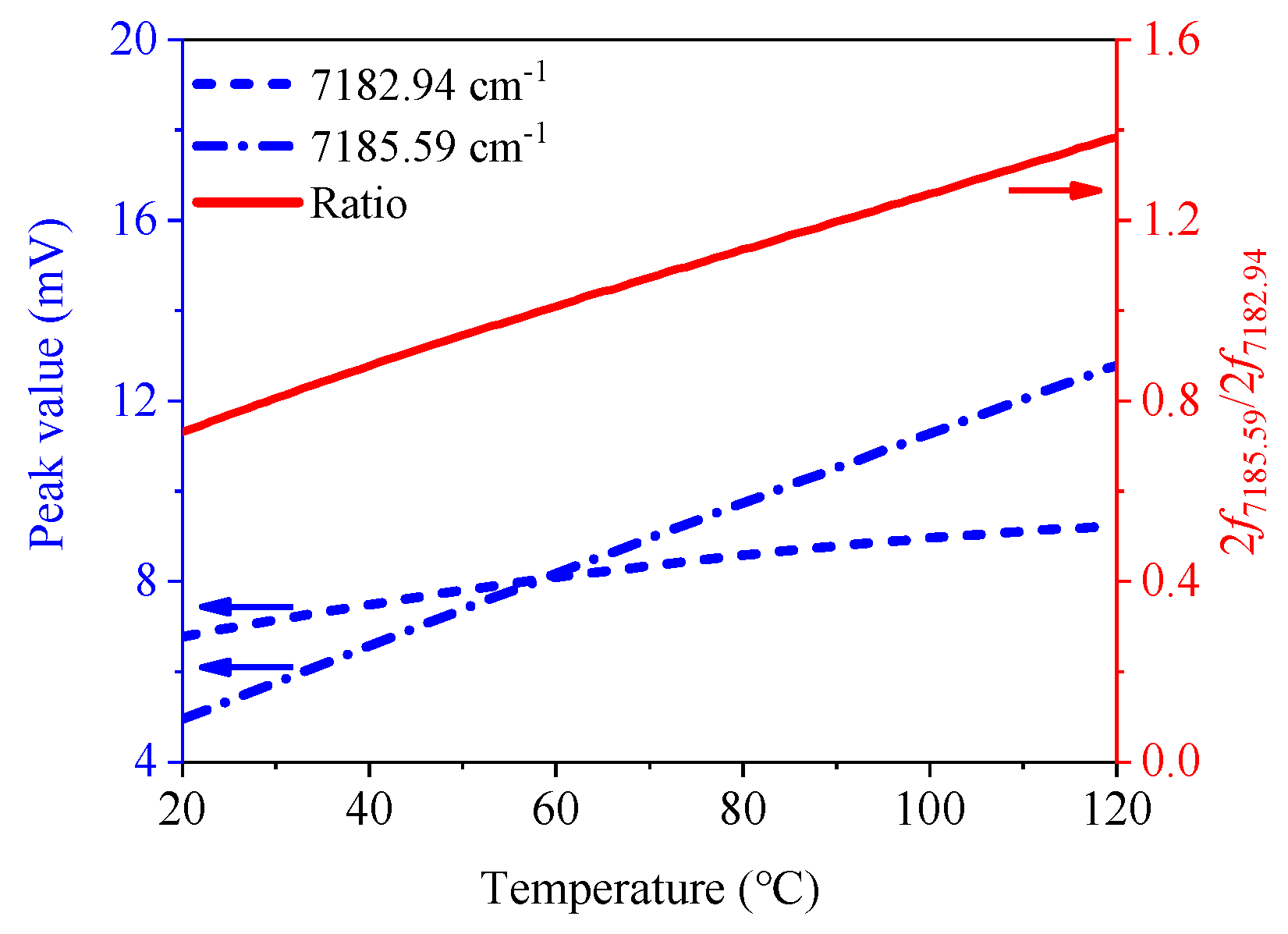
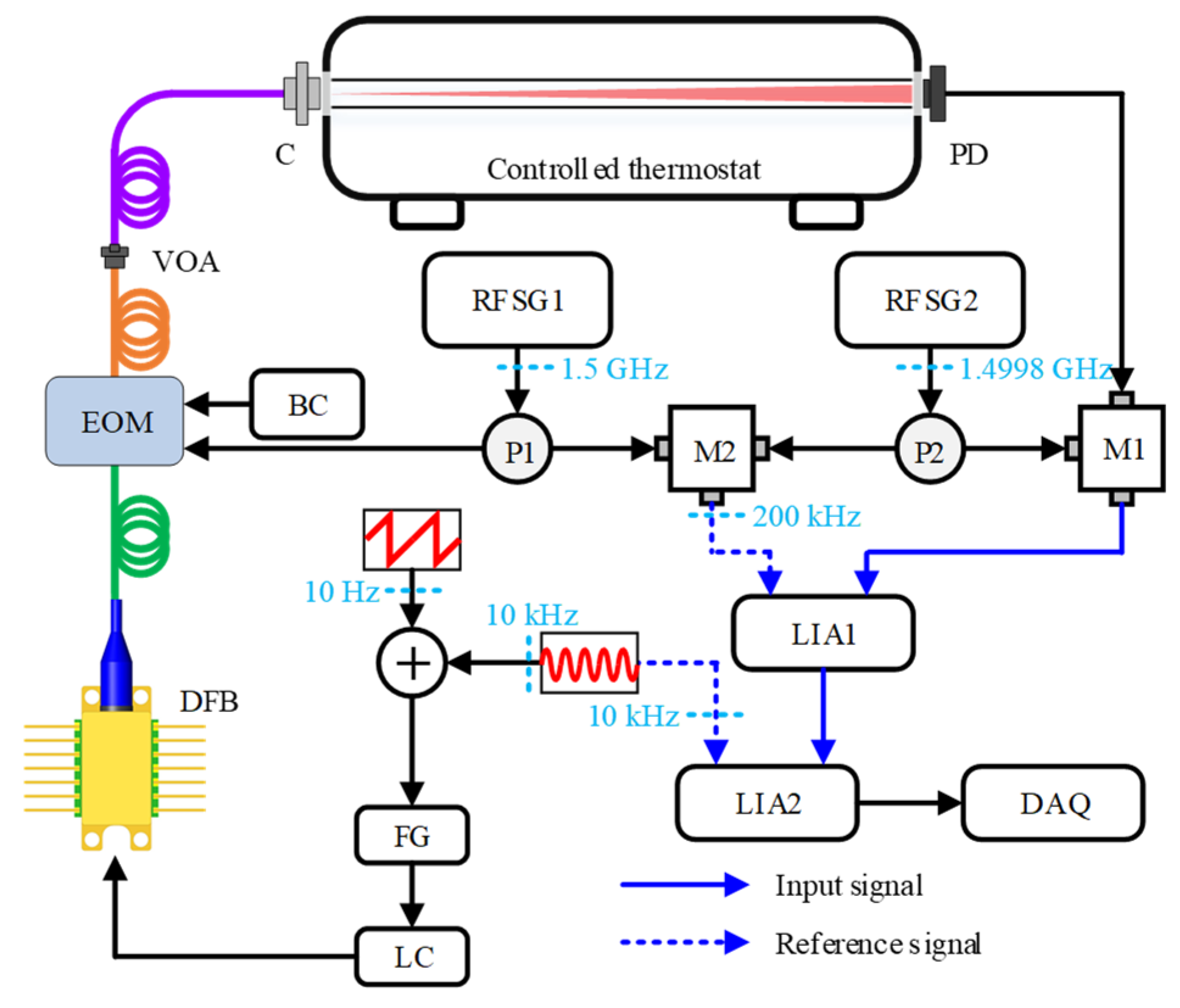

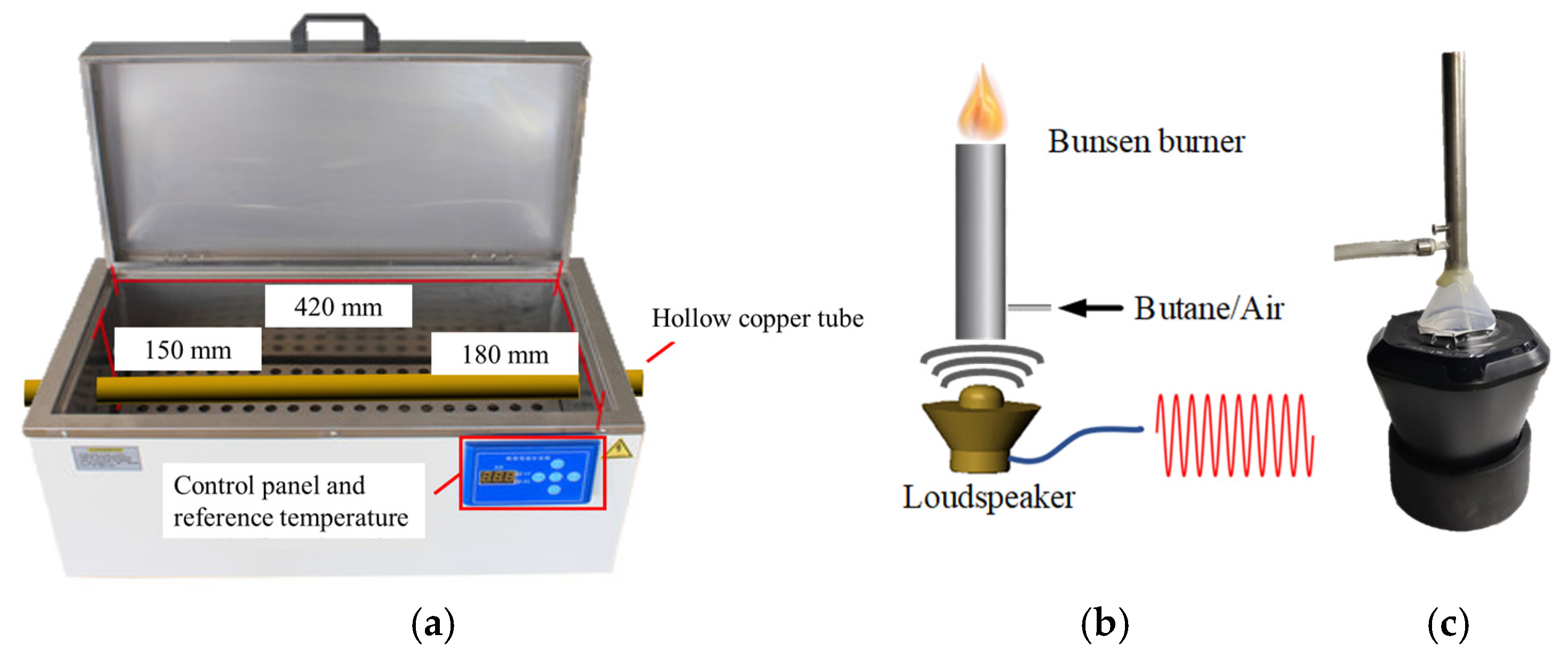
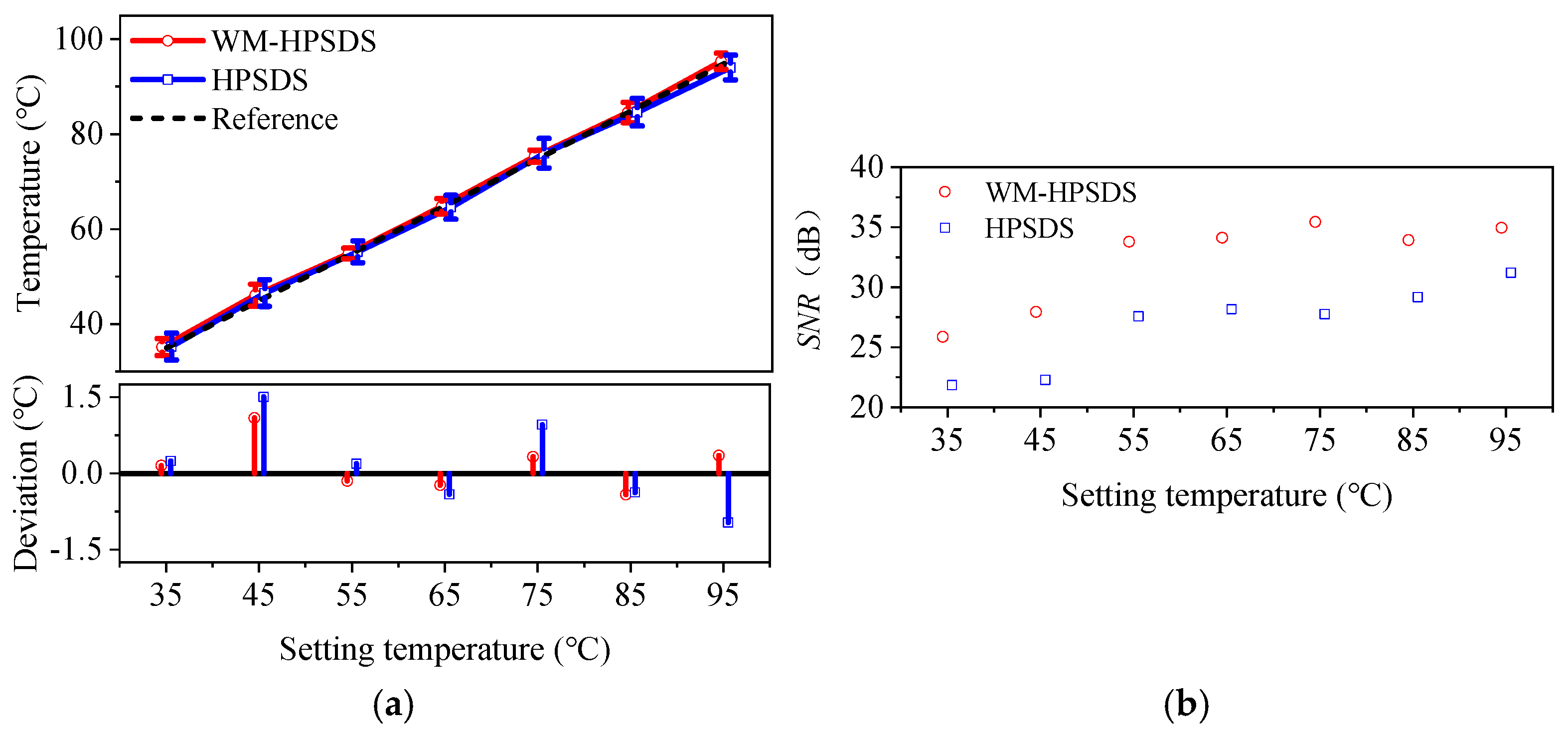
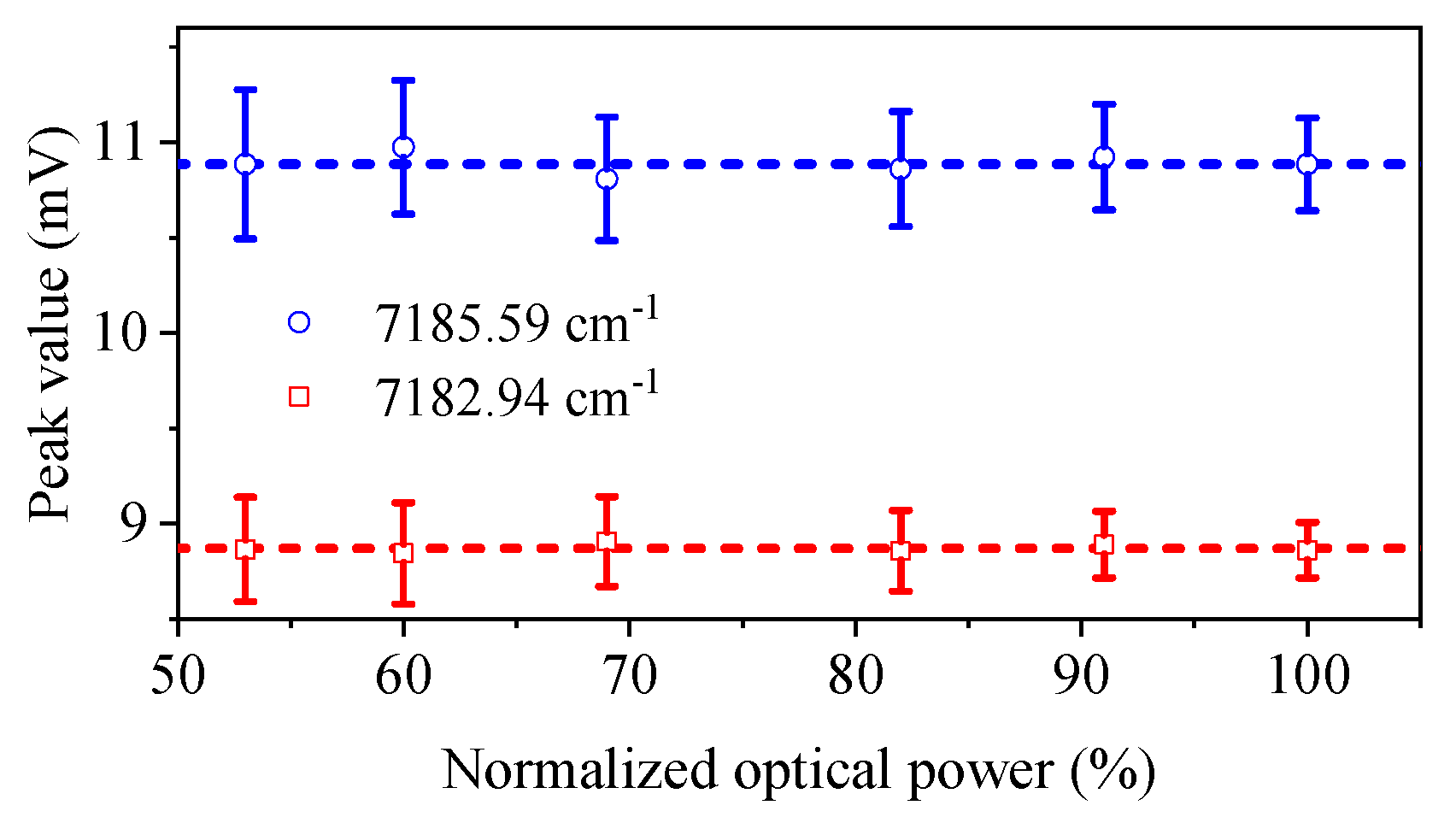
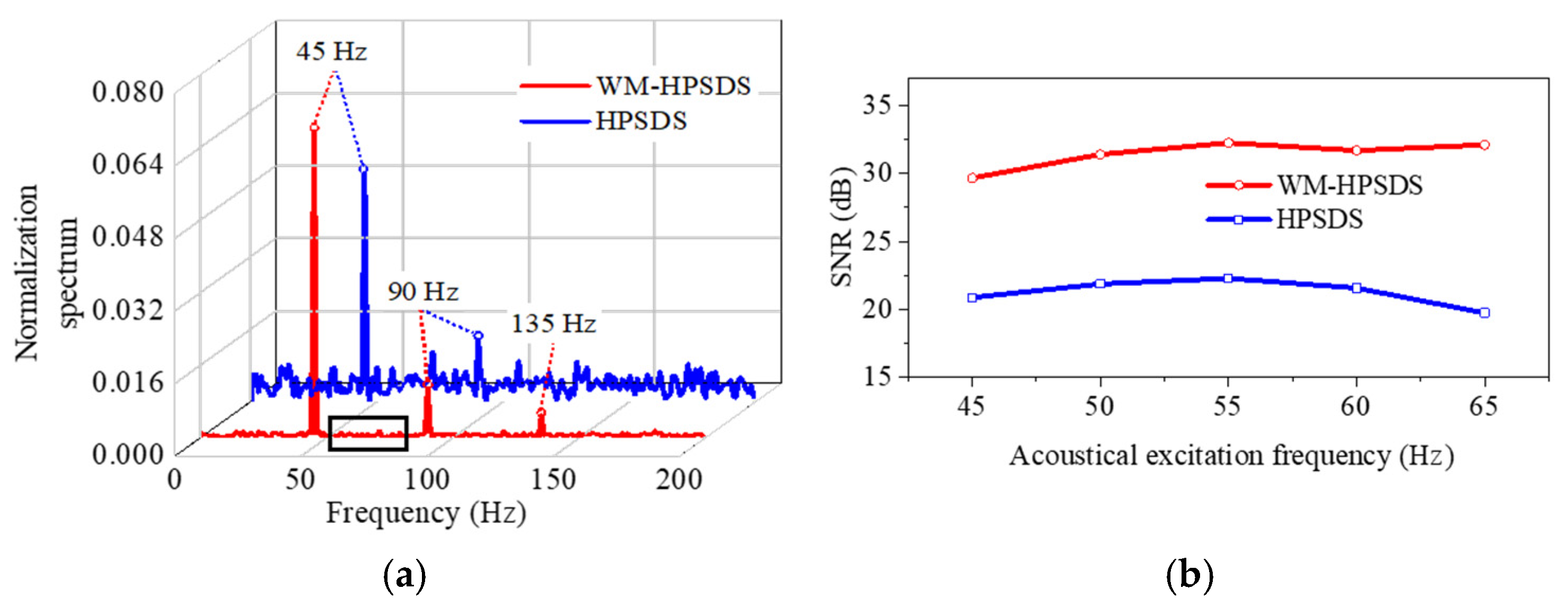
Disclaimer/Publisher’s Note: The statements, opinions and data contained in all publications are solely those of the individual author(s) and contributor(s) and not of MDPI and/or the editor(s). MDPI and/or the editor(s) disclaim responsibility for any injury to people or property resulting from any ideas, methods, instructions or products referred to in the content. |
© 2025 by the authors. Licensee MDPI, Basel, Switzerland. This article is an open access article distributed under the terms and conditions of the Creative Commons Attribution (CC BY) license (https://creativecommons.org/licenses/by/4.0/).
Share and Cite
Wang, G.; Wang, R.; Zhao, W. Precise Temperature Measurement Through Wavelength Modulation Heterodyne Phase-Sensitive Dispersion Spectroscopy. Photonics 2025, 12, 537. https://doi.org/10.3390/photonics12060537
Wang G, Wang R, Zhao W. Precise Temperature Measurement Through Wavelength Modulation Heterodyne Phase-Sensitive Dispersion Spectroscopy. Photonics. 2025; 12(6):537. https://doi.org/10.3390/photonics12060537
Chicago/Turabian StyleWang, Guoquan, Rende Wang, and Weiqian Zhao. 2025. "Precise Temperature Measurement Through Wavelength Modulation Heterodyne Phase-Sensitive Dispersion Spectroscopy" Photonics 12, no. 6: 537. https://doi.org/10.3390/photonics12060537
APA StyleWang, G., Wang, R., & Zhao, W. (2025). Precise Temperature Measurement Through Wavelength Modulation Heterodyne Phase-Sensitive Dispersion Spectroscopy. Photonics, 12(6), 537. https://doi.org/10.3390/photonics12060537



